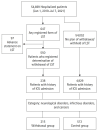Comparison of factors influencing the decision to withdraw life-sustaining treatment in intensive care unit patients after implementation of the Life-Sustaining Treatment Act in Korea
- PMID: 38863360
- PMCID: PMC11167413
- DOI: 10.4266/acc.2023.01130
Comparison of factors influencing the decision to withdraw life-sustaining treatment in intensive care unit patients after implementation of the Life-Sustaining Treatment Act in Korea
Abstract
Background: The decision to discontinue intensive care unit (ICU) treatment during the end-oflife stage has recently become a significant concern in Korea, with an observed increase in life-sustaining treatment (LST) withdrawal. There is a growing demand for evidence-based support for patients, families, and clinicians in making LST decisions. This study aimed to identify factors influencing LST decisions in ICU inpatients and to analyze their impact on healthcare utilization.
Methods: We retrospectively reviewed medical records of ICU patients with neurological disorders, infectious disorders, or cancer who were treated at a single university hospital between January 1, 2019 and July 7, 2021. Factors influencing the decision to withdraw LST were compared between those who withdrew LST and those who did not.
Results: Among 54,699 hospital admissions, LST was withdrawn in 550 cases (1%). Cancer was the most common diagnosis, followed by pneumonia and cerebral infarction. Among ICU inpatients, LST was withdrawn from 215 (withdrawal group). The withdrawal group was older (78 vs. 75 years, P=0.002), had longer total hospital stays (16 vs. 11 days, P<0.001), and higher ICU readmission rates than the control group. There were no significant differences in the healthcare costs of ICU stay between the two groups. Most LST decisions (86%) were made by family.
Conclusions: The decisions to withdraw LST of ICU inpatients were influenced by age, readmission, and disease category. ICU costs were similar between the withdrawal and control groups. Further research is needed to tailor LST decisions in the ICU.
Keywords: cancer; death; healthcare cost; intensive care unit; palliative care; terminal care.
Conflict of interest statement
No potential conflict of interest relevant to this article was reported.
Figures



Similar articles
-
Changes in Pediatric End-of-Life Process After the Enforcement of the Act on Life-Sustaining Treatment Decisions-The Experience of a Single Children's Hospital.Healthcare (Basel). 2024 Oct 29;12(21):2156. doi: 10.3390/healthcare12212156. Healthcare (Basel). 2024. PMID: 39517368 Free PMC article.
-
Comparison of the end-of-life decisions of patients with hospital-acquired pneumonia after the enforcement of the life-sustaining treatment decision act in Korea.BMC Med Ethics. 2023 Jul 18;24(1):52. doi: 10.1186/s12910-023-00931-y. BMC Med Ethics. 2023. PMID: 37461075 Free PMC article.
-
Participation and Influencing Factors in the Decision-Making of Life-Sustaining Treatment: A Focus on Deceased Patients with Hematologic Neoplasms.J Hosp Palliat Care. 2023 Jun 1;26(2):69-79. doi: 10.14475/jhpc.2023.26.2.69. J Hosp Palliat Care. 2023. PMID: 37753507 Free PMC article.
-
Physicians' attitudes and experiences about withholding/withdrawing life-sustaining treatments in pediatrics: a systematic review of quantitative evidence.BMC Palliat Care. 2023 Sep 29;22(1):145. doi: 10.1186/s12904-023-01260-y. BMC Palliat Care. 2023. PMID: 37773128 Free PMC article.
-
End-of-life decisions in the Intensive Care Unit (ICU) - Exploring the experiences of ICU nurses and doctors - A critical literature review.Aust Crit Care. 2016 May;29(2):97-103. doi: 10.1016/j.aucc.2015.07.004. Epub 2015 Sep 19. Aust Crit Care. 2016. PMID: 26388551 Review.
Cited by
-
End-of-life care in the intensive care unit: the optimal process of decision to withdrawing life-sustaining treatment based on the Korean medical environment and culture.Acute Crit Care. 2024 May;39(2):321-322. doi: 10.4266/acc.2024.00675. Epub 2024 May 30. Acute Crit Care. 2024. PMID: 38863363 Free PMC article. No abstract available.
-
Determinants of Limiting Life-Sustaining Treatment in Critically Ill COVID-19 Patients: A Multicenter Study in Korean Intensive Care Units.Tuberc Respir Dis (Seoul). 2025 Jul;88(3):557-565. doi: 10.4046/trd.2024.0137. Epub 2025 Apr 28. Tuberc Respir Dis (Seoul). 2025. PMID: 40289772 Free PMC article.
References
-
- Welfare Ministry of Health and Welfare . Act on decisions on life-sustaining treatment for patients in hospice and palliative care or at the end of life. No. 17218. Welfare Ministry of Health and Welfare; 2020.
-
- Council on Ethical and Judician Affairs, American Medical Association. Medical futility in end-of-life care: report of the council on ethical and judicial affairs. JAMA. 1999;281:937–41. - PubMed
-
- Curtis JR, Vincent JL. Ethics and end-of-life care for adults in the intensive care unit. Lancet. 2010;376:1347–53. - PubMed
Grants and funding
LinkOut - more resources
Full Text Sources

